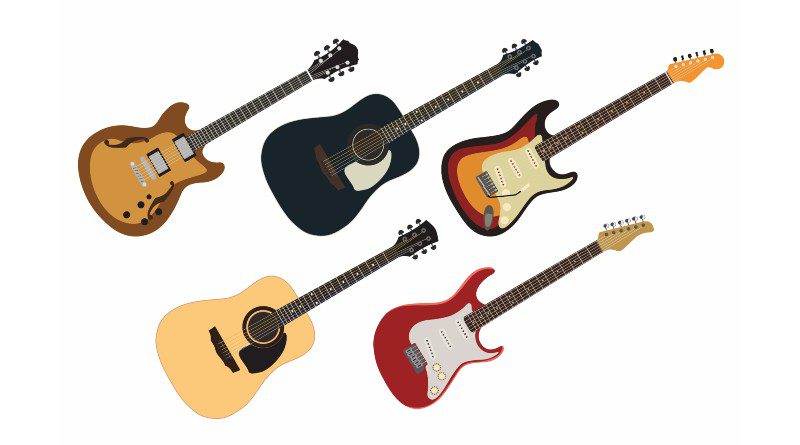Guitars are one of the oldest stringed instruments, and over their centuries of development, many different styles have evolved, and in many cases, these guitars are designed for specific genres.
Beginner guitarists often have difficulty navigating through the huge variety of guitar variants on the market, so the purpose of this KillerGuitarRigs Guide is to walk you through the options available and to go into depth about their suitability for different genres, styles and uses.
When asked, most people will be familiar with acoustic guitars and electric guitars and not much else (though they’ll recognize a bass guitar if prodded) – but there’s a world of more specific and interesting guitars out there.
Let’s take a look.
Contents
How to Choose A Guitar Style
As mentioned above, there are a huge number of styles available, but fortunately, most aspiring guitarists already know what style of music they like to play, and which artists inspire them. Having this information goes a long way towards making a decision on the type of guitar that’s right for you.
Beginners often start out on acoustic guitars – there seems to be a perception that they are “less noisy” than electric guitars, but in many cases, this is not true. Electric guitars can be played unplugged for practicing the fundamentals (chords, scales, etc.), whereas an acoustic guitar is always at full volume. Not only that, but acoustic guitars are usually supplied with heavier gauge strings than an electric, making it more difficult to finger chords, play bends, and get up and down the fretboard (though you can get low action acoustic guitars that make things a little easier).
This isn’t to say don’t start with an acoustic guitar, it serves to point out that all guitars are suitable if it’s what you want to play. If you start on an acoustic, but you dream of playing doom metal, the acoustic will only take you so far before you have to invest in an electric. Similarly, if you want to play classical guitar, you will have trouble achieving the tones you’re looking for on a Stratocaster.
Types Of Guitar – Acoustic Guitars

Acoustic guitars are typically all wood, although some brands like Ovation use fiberglass composite in their construction. The top of the guitar is known as the soundboard – this acts as an amplifier of sorts. The vibrations of the strings pass through the bridge and saddle, and from there to the soundboard.
Soundboards are made from tone woods, which are special types of wood selected for their tonal properties. The type of wood used can drastically affect how an acoustic guitar sounds (and how much it costs).
Denser woods like mahogany and maple provide deep, rich tones with an emphasis on the low end, whereas lighter woods like Sitka spruce, which is one of the most commonly used soundboard tone woods, are tonally much brighter.
What Are The Different Types Of Acoustic Guitar?
There are several types of acoustic guitar within the acoustic guitar family, each serving a different purpose within the wider range of instruments.
Steel String Acoustic Guitar
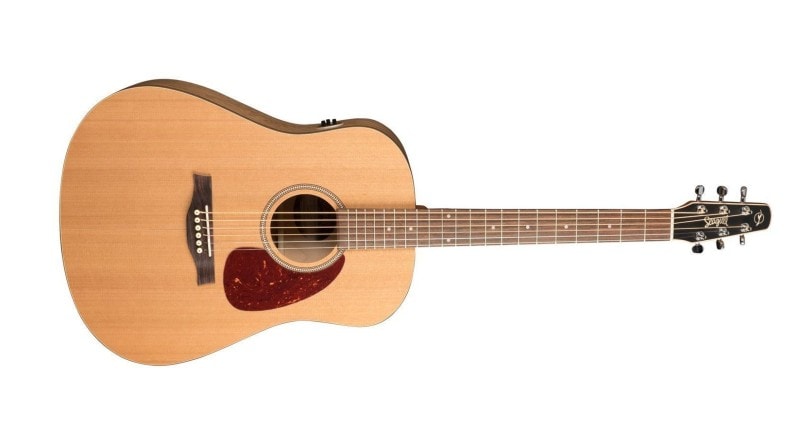
Steel string acoustic guitars are the most commonly owned type. The beauty of these instruments lies in their simplicity, although there is more to them than meets the eye. There are several body styles available, including:
- Dreadnought
- Jumbo
- Parlor
- Travel
- Concert
- Auditorium
- Symphony
- Orchestra
The body style impacts projection and volume, and it does slightly influence the guitar’s tone, too. Large, deep bodied guitars like the Jumbo, Dreadnought, and Orchestra styles are usually the loudest, with a deep, bassy quality.
Smaller styles of steel string acousticguitar like the Auditorium, Concert, and Symphony are best suited to fingerstyle guitar. They offer a brighter sound that easily cuts through a mix, and stand up well on their own, too.
Parlor and travel guitars are the smallest of the acoustics. While they’re ideal for strumming at home, they have also proven themselves to be more than capable for live performances and recording at the highest levels – Ed Sheeran is known for using a “Little Martin” ¾ Scale guitar, and John Mayer has his signature Martin Stagecoach, widely regarded as the original travel guitar.
What Styles Of Music Are Steel String Acoustic Guitars Suited To? Steel string acoustic guitars are exceptionally versatile instruments, they can be used to great effect across a wide range of genres. They work well for country, delta blues, pop, rock, fingerstyle, indie, folk, and more.
Are Steel String Guitars Suitable For Beginners? These guitars are definitely suitable for beginners, although some much more so than others. Although, when beginners play guitars with high action and heavy gauge strings, they can experience pain in the fingertips. Callouses will develop over time, and they will help, but until then just playing can be uncomfortable, which can deter beginners from picking up the guitar.
Beginners should look for steel string acoustic guitars with the lowest action possible. Action is the height of the strings above the fretboard, the lower the action, the less effort that is required in order to depress the strings and play notes (more on this here). Of course, the action on most steel stringed acoustics can be lowered to your personal taste, but this often requires a permanent modification to the guitar, so you should wait until you’re confident enough to tackle that kind of adjustment or take it to a luthier for professional help.
Beginners should also try and stick to the smaller and mid sized steel string acoustics. Due to their size, jumbo, orchestra, and dreadnought guitars can be difficult to hold, which can make learning proper technique tougher.
Nylon String Acoustic

Nylon stringed acoustic guitars, sometimes referred to as classical guitars or Spanish guitar, have some key differences from the steel string acoustics described above. First of all, the strings – they are tuned identically (EADGBE), but the strings are made from nylon (check out our article on why you shouldn’t put nylon strings on a steel string guitar).
Nylon guitar strings weren’t always made with synthetic polymers. Prior to WWII, classical guitars typically used strings known as catgut – while they were made from animal intestines, they weren’t ever made using cats, or any part of a cat.
Like many classical instruments, classical guitars don’t differ too much in style between manufacturers. In general, the shape remains the same, but there are various sizes available, providing options for all ages of player”
- The ¼ size classical guitar is best suited to players 4 to 6 years old
- The ½ size classical guitar is best suited to players 5 to 8 years old
- The ¾ size classical guitar is best suited to players 8 to 11 years old
- The full size classical guitar is suitable for players ages 11 through to adulthood
While the shape between manufacturers doesn’t change much, it does change slightly depending on whether it is a classical guitar or flamenco style guitar. Classical style nylon acoustics need bell like clarity and avoid fret buzz with a higher action and mild neck relief. To get a bright tone, classical guitars are almost exclusively made with cedar or spruce soundboards. Typically, they are always hourglass shaped, although on rare occasions, they will come with a cutaway for high fret access.
Flamenco style on the other hand, are designed for fast playing and unlike almost any other guitar in the world, fret buzz is strongly encouraged! Action is extremely low, and there is no neck relief. This makes playing extremely easy, but if you’re not specifically playing flamenco, the fret buzz can become bothersome. There are two types of flamenco style nylon acoustics, blanca and negra. Blanca are bright and vibrant and use a spruce top and cypress back to emphasize these tones, negra flamenco guitars offer darker tones, and use woods other than cypress for the back and sides.
What Styles Of Music Are Nylon String Acoustic Guitars Suited To? The nylon strung acoustic guitar is ideally suited to classical and flamenco styles of music, although, it plays well for folk and jazz, too. The tones are soft and mellow, and this tends to equal low volume, and due to the low string tension, just playing harder won’t do much to overcome this.
Are Spanish Guitars Suitable For Beginners? You may hear some people saying that you should always start playing on a nylon string acoustic, and while the added comfort does make them a good choice for beginners, there are other factors to consider.
One of the biggest benefits of using nylon strings as a beginner is that they are gentle on the fingers. Given that they are smooth, unlike steel strings which are wound, there is less friction. They are also strung at much lower tension than steel strings, making them easier to depress.
There are some downsides to nylon strung acoustics for beginner players, though. First, the width of the fretboard – these guitars have very wide fretboards, and this can make it difficult for new players to stretch out their fingers to play certain chords.
Next is the limited range of styles that these guitars are suited to. They can technically play most guitar music, but they won’t sound particularly good playing genres out of their wheelhouse.
Finally, restringing. Restringing a nylon strung acoustic guitar takes practice and skill. Other styles of guitar have strings with a ball end that simply slot into place. Nylon acoustics require the ends to be tied to the bridge using a special type of knot. If you don’t get this right, you will have serious tuning stability issues.
Acoustic-Electric Guitars
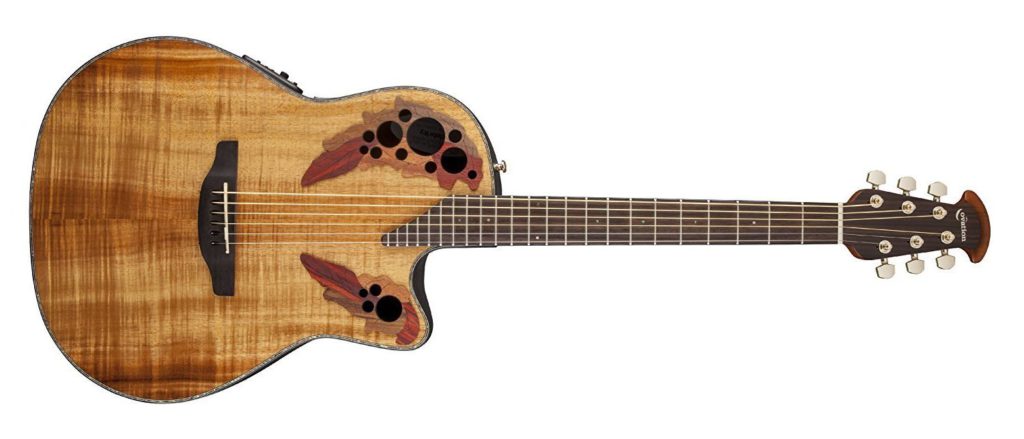
The Acoustic-Electric guitar (also known as the electro acoustic guitar) comes in almost every form in which you can buy an acoustic guitar. They are effectively regular acoustic guitars fitted with pickups, an output jack, a preamp, and in some cases built in EQ and tuners (not to be confused with hybrid guitars which are between an electric and acoustic).
The most common pickup types found in acoustic-electric guitars are piezo-electric. Rather than using the electromagnetic field generated by strings moving over magnets, piezo pickups use the vibrations of the strings directly which tends to result in the most authentic sound for an electro acoustic guitar. Because they don’t require magnetism, they can even be used with nylon strung guitars.
What Styles Of Music Are Electro Acoustic Guitars Suited To? Electric-acoustic guitars can play whatever their counterpart acoustic-only guitars can handle. It is worth noting that playing acoustic-electric guitars do lose some of the qualities provided by their tone woods when played through pickups.
When you’re playing an electro acoustic guitar plugged in, you can also plug into effects pedals just like you can with a solid body electric guitar. This is particularly useful for solo artists who use looper pedals to play rhythm for themselves while they solo over the top.
Are Electro Acoustic Guitars Suitable For Beginners? Acoustic-Electric guitars are absolutely suited to beginners. They play almost identically to their acoustic-only equivalents but offer the possibility of playing through an amp should you ever want to play to a bigger audience.
Resonator Guitars
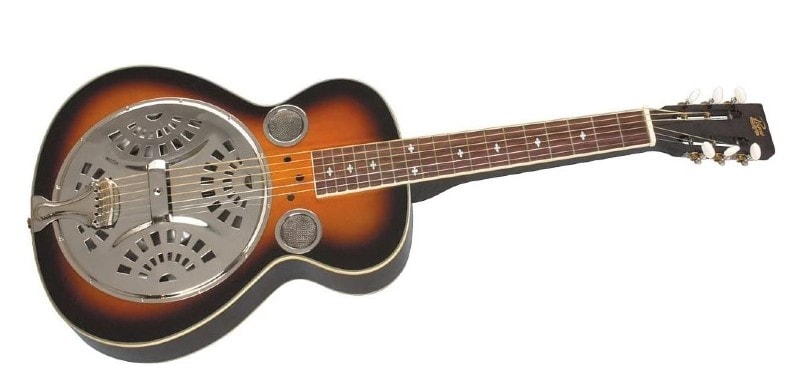
Resonator guitars are alternative design acoustic guitars that feature a spun metal cone in place of the sound hole, some models in fact feature several cones. This means that they don’t rely on a soundboard. Resonator guitar bodies are made either from wood in a dreadnought pattern, or, in some cases, they are entirely metal.
What Styles Of Music Are Resonator Guitars Suited To? Resonators were originally designed in order to be heard over brass and percussion instruments in big bands, but soon found popularity elsewhere. The use of metal components in a resonator guitar produces a very unique, almost springy tone, and this made them extremely popular for blues, bluegrass, country and folk – they are also prized by slide guitar players.
Are Resonator Guitars Suitable For Beginners? Resonator guitars are an extremely niche style of instrument. They have a very high action, which is one of the reasons why they are so well suited to slide. For these reasons they may not be the best style for a beginner, as learning may well be uncomfortable, and the tonal range is more limited than an acoustic guitar.
Types Of Guitar – Electric Guitar
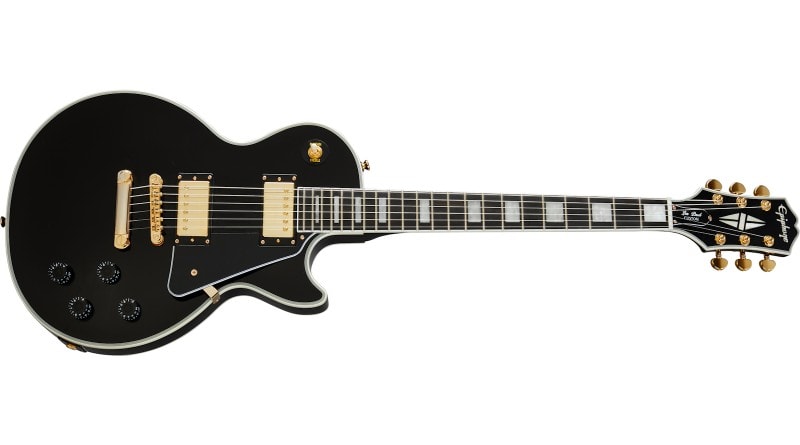
The electric guitar was invented back in the early 1930s and is said to have been developed by Mr. Paul Tutmarc. As music evolved, more emphasis was placed on the guitar within bands, and in order to cut through the mix they needed to be amplified.
Electric guitars are equipped with one or more pickups, usually electromagnetic, and come in all shapes and sizes. Unlike acoustic guitars, the shape has very little, if any, impact on the overall sound and tone, which has led to some serious creativity from manufacturers, and some iconic designs over the years.
Weight and wood density do, however, impact the sound of an electric guitar, which is why manufacturers use various woods to extract different tones out of their instruments. For example, the Gibson Les Paul is usually made with a mahogany body and neck – mahogany is a very heavy wood, and this is instrumental in creating the signature tone and sustain this guitar is known for.
What Are The Different Types Of Electric Guitar?
There are three main types of electric guitar, and of course, dozens of designs and styles available within those categories.
Solid Body Electric Guitars
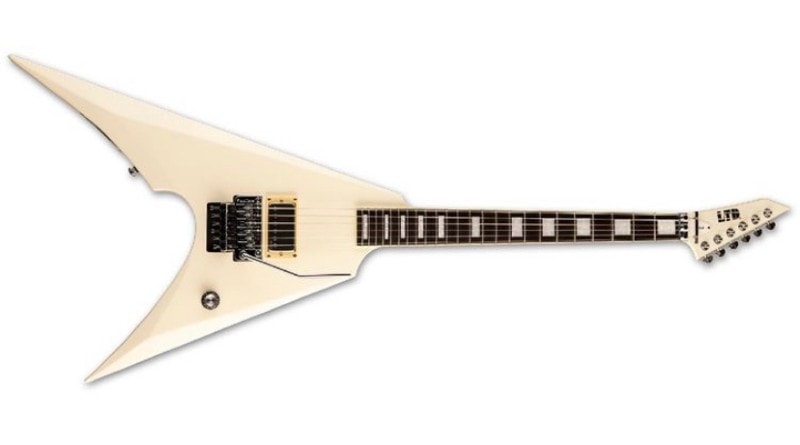
Solid body is the style most people automatically picture when asked to think of an electric guitar. There is much debate over who actually invented it first – some credit Les Paul, while others recognize O.W. Appleton as the originator. Either way, the solid body electric caught on in a way that no manufacturer ever thought it would, and this led to the very first mass produced example – Leo Fender’s Fender Esquire.
One of the things that makes solid body guitars so special is the ability to customize to the player’s exact specification. Almost any piece of hardware on these guitars can be upgraded, from tuners to pickups – meaning you can start with a cheaper guitar and upgrade as your skills improve without needing to invest in a whole new instrument. See our Ultimate Stratocaster upgrade guide for detailed examples of how you can modify a solid body electric guitar.
What Styles Of Music Are Electric Guitars Suited To? The solid body electric guitar can be used on pretty much every style of music – country, pop, jazz, blues, rock, metal, and even classical! Part of what makes these guitars so versatile is the number, type, and location of pickups.
As well as pickup varieties, solid body guitars gain versatility from their responsiveness to effects. The same guitar can shred a metal riff and cross over to classical arpeggios with just the press of a button.
Are Electric Guitars Suitable For Beginners? Solid body guitars make perfect guitars for beginners. They are available at prices to suit literally any budget, and most models offer a lot of adjustability. This means you can adjust neck relief, height of action and more to suit your style of play. Not only that, but electric guitars can use a much lighter string gauge than acoustic guitars, making them very easy on the fingers.
Semi Hollow Body Electric Guitars
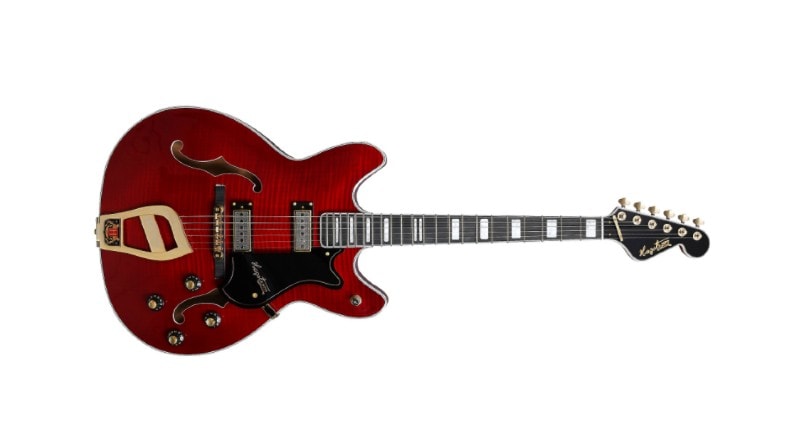
Semi hollow body guitars were designed in order to counter the infamous feedback issues that plagued the early hollow body “Spanish Style” electric guitars. Their name comes from a solid wooden block that runs through the center of the body, leaving the sides, or bouts, hollow.
The most recognizable of all of the semi hollow body guitars is the Gibson ES-335, although many manufacturers make similar looking instruments. Tonally, a semi hollow bodied electric guitar sounds very similar to a solid body, although sustain is reduced, and the lows are a little less focused – check out our favorite semi-hollow bodied guitars here.
What Styles Of Music Are Semi Hollow Body Guitars Suited To? Despite their retro looks, semi hollow guitars are actually used across many of the same genres as solid body. They are used for rock, country, classical, pop, indie, even metal! These guitars are, however, especially popular amongst jazz and blues players as they offer the tight focus that comes with solid body, but also the warmth and rounded tones that come with acoustic guitars.
Are Semi Hollow Body Guitars Suitable For Beginners? Semi hollow guitars are suitable for beginners, although some models like the ES-335 are quite large, so can be uncomfortable to play for beginners. Beginners may want to consider smaller models, like the Epiphone ES-339 for example – they offer much of the same tone as larger guitars but are generally easier to handle.
Hollow Body Electric Guitars
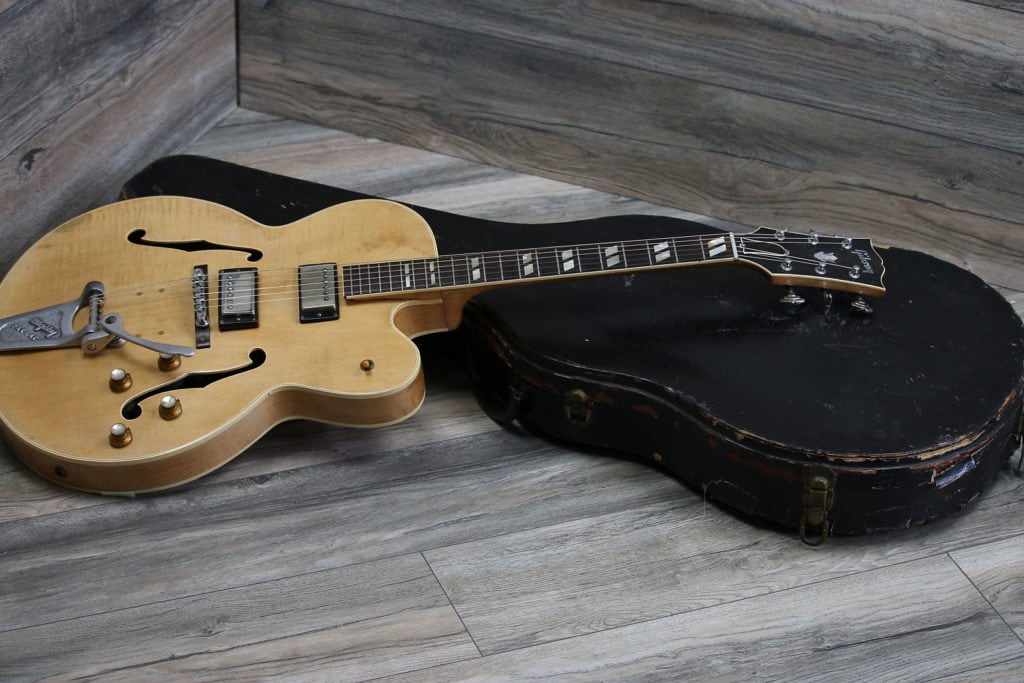
These are the guitars that started the electric guitar revolution. Hollow body guitars actually started life as archtop guitars like the Gibson L-50 that were fitted with Charlie Christianson pickups. This was done so guitarists in bands could start to play single note solos and be heard over the rest of their group.
Today, hollow body guitars have gotten much narrower than the archtop guitars that preceded them, and frequently, from the outside at least, look just like semi hollow guitars. When played acoustically, they are noticeably louder and clearer than both solid body and semi hollow bodied guitars but are still much quieter and less full bodied than a true acoustic guitar. Check out our list of the best hollow body electric guitars here.
Archtop guitars can still be found on the market and make for great playing and sounding jazz/bebop guitars (check our list of the best guitars for jazz here).
What Styles Of Music Are Hollow Body Guitars Suited To? Hollow body guitars are best suited to clean styles – due to their inherent feedback issues, they don’t handle high gain and distortion very well, meaning metal and heavy rock aren’t going to sound great on these instruments.
They have an exceptionally warm sound, so, when it comes to jazz, blues, pop, and classical, hollow body guitars are genuinely in their element. You’ll also find archtop guitars popular with a lot of rock n roll and jazz guitarists.
Are Hollow Body Guitars Suitable For Beginners? Much like semi hollow body guitars, hollow bodies are quite large, making them a little awkward to hold, especially for beginners. Larger players should be OK, but those with a smaller frame may struggle. In addition, managing the feedback may also present challenges to newer guitarists. If the look is a must, a semi hollow may well be a better choice.
12 String Guitars
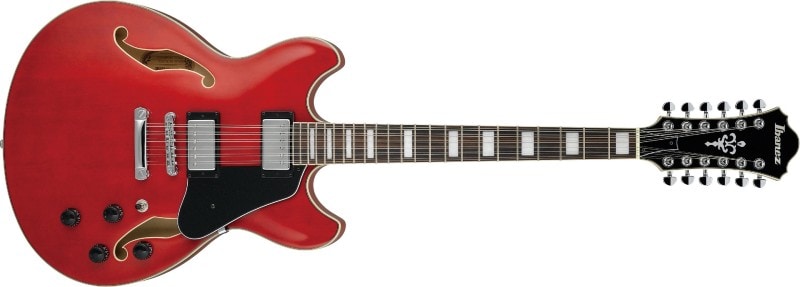
12 String guitars can seem quite intimidating at first, but when you realize that they are played almost identically to a 6 string, including chord structures and scales, the intimidation subsides. The way twelve string guitars are tuned provides a shimmering chorus-like effect, sometimes referred to as the “jingle-jangle” sound.
These instruments do so much more than jingle jangle, though. Twelve string guitars have a full tonal range, from bright and shimmering, through to warm, mellow sounds. Some of the most iconic songs in history have been written on and recorded with 12 string guitars, including Pink Floyd’s, Wish You Were Here, and even Led Zeppelin’s, Stairway to Heaven.
They are available as both an electric and acoustic guitar format, although acoustic are far more common. Interestingly enough, when you see double neck guitars, Jimmy Page’s double neck Gibson SG, for example, you are normally looking at a 6 string and a 12 string rolled into one instrument. They are also surprisingly affordable – most people assume they’re quite expensive, but there are some great 12 strings on the market under $1000.
The below image shows how these guitars are tuned:

We also have a full article on tuning 12 string guitars if you’re interested in learning the possibilities.
What Styles Of Music Are Twelve String Guitars Suited To? As evidenced by their presence on some of the biggest rock and pop hits throughout the last 50 years, twelve string guitars can handle those style very well. They are also very well suited to folk and country, too.
Are Twelve String Guitars Suitable For Beginners? The string tension on 12 string guitars makes them fairly prohibitive to new players. While chord structures are identical to 6 strings, technique is modified due to the fact that you need to play 2 strings per note. They are a great choice for players who are already accomplished finger pickers, but beginners may find that learning progress is slow if they start on a 12 string.
Extended Range Guitars

Within the extended range family there are guitars with 7, 8 and even 9 strings. Unlike 12 strings guitars, the strings aren’t in matched pairs, rather, the guitars have the typical EADGBE, but add extra strings at the bass end:
- 7 String: BEADGBE
- 8 String: F#BEADGBE
- 9 String: C#F#BEADGBE
This bass heavy extended range makes these guitars extremely popular with metal players. The increased scale allows for additional creativity in soloing, too. You can check out our article about 7 string tunings here. Typically a band with extended range guitars will have less of a focus on the bass guitar, sometimes having the bassist play a 6 or 7 string bass guitar, or in some rare instances no bass guitar at all.
Also belonging to the extended range family are fanned fret guitars. These instruments are characterized by their non horizontal fret arrangements. Standard guitars are measured by their scale length (full scale length guide here), which is the distance between the nut and the bridge, but fanned fret instruments have 2 or more scale lengths due to their design and are referred to as multi-scale.
Lower pitched notes sound better on a longer string due to the extra freedom they have to vibrate, so the aim of a fanned fret instrument is to be able to overcome these issues by extending the length of the bass strings while still keeping the high strings short.
What Styles Of Music Are Extended Range Guitars Suited To? These guitars are primarily aimed at metal players, although they can be used for just about any genre that you could use a solid body electric guitar for.
Are Extended Range Guitars Suitable For Beginners? Of all of the guitar types in this guide, extended range instruments are probably the least suitable guitars for beginners. They have extremely wide necks, and the additional strings and potentially not traditional fret layouts can cause discomfort and unnecessary confusion to a new player.
Types Of Guitar – Bass Guitar

The bass guitar works to provide the deep lows in a band, but is also capable of playing awesome solos in the right hands. Like 6 string and even some extended range guitars, the bass guitar is available as an acoustic or solid body electric instrument. Standard bass guitars are tuned the same as the bass end of a 6 string guitar (EADG), however extended range basses are also available, in fact the 5 string bass guitar is extremely popular.
What Styles Of Music Are Bass Guitars Suited To? Bass guitars span the genres – no matter the specific style, there’s likely to be a need for a bass accompaniment. Bass guitars are particularly prominent in styles like jazz and funk, where in many cases they are featured front and center, rather than as backing instruments, such as how you would hear the bass guitar in a rock band.
Are Bass Guitars Suitable For Beginners? While they are part of the wider guitar family, bass guitars are an entirely different instrument to the 6 string guitar. Fortunately, many of the fundamentals are the same, including scales, so crossover between a bass guitar and a regular electric or acoustic guitar is quite straight forward should a beginner decide to switch over. Bass guitars don’t usually play chords, as bass lines are mostly single note runs, although some 2 note chords are relatively common. Bass guitar also occasionally requires some advanced techniques in certain genres, too, slap bass for example in the funk and jazz arenas.
Types Of Guitar – Lap Steel

Lap steel guitars are exactly what they sound like – steel string guitars that sit in a horizontal position in your lap. Also known as “pedal steel” or “Hawaiian” guitars, the lap steel can also come on a stand, and is typically played with a slide. On a regular electric or acoustic guitar, the player sounds notes by pressing down the string to the fret, but on a lap steel the frets are only markers – you never press the strings down.
What Styles Of Music Are Lap Steel Guitars Suited To? Lap steel guitars are most common in country and Hawaiian music, but in some instances can be found in blues and jazz.
Are Lap String Guitars Suitable For Beginners? A lap steel would be quite difficult as a first instrument as the combination of slide motion and alternative tunings would make the instrument quite a challenge compared to more common styles of guitar. However, the use of a slide to sound out the notes as opposed to physically fretting the strings would make it somewhat easier on the fingers in a physical sense.
Final Thoughts On Guitar Types
Most people starting out will reach for the most common type of guitar to their style of music – almost certainly either an electric or acoustic guitar.
However, as you get deeper into learning the instrument and finding out more about different styles of music, be it developing an interest in playing slide guitar, emulating your favourite jazz guitarists, or even getting nutty with a pedal steel guitar, there is a more specific niche of guitar out there for you.
Whether you’re a long time player looking to switch to a different style, or you’re an all-out beginner trying to decide between guitars, we hope this guide to guitar types has been helpful! Choosing a guitar from such a wide selection can be daunting and making the wrong decision can actually make progression that much harder.
An easy way to start narrowing your selection down is to take a look at what your influences play. If they have a sound that you want to replicate, replicating their gear, or at least the style of their gear is a great place to start.
The final advice we will offer is to try out as many guitars as you can. In stores, at friend’s houses, wherever you can. You might find that a style you’d never previously considered actually suits you well.

